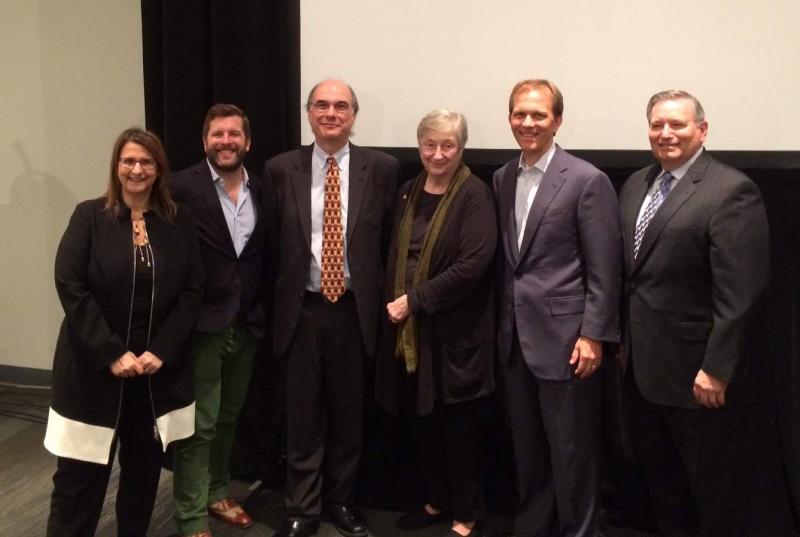- Categories:
Brick-and-Mortar Retail in the Spotlight at BEA [5]
- By Sydney Jarrard [6]

The American Booksellers Association and BookExpo America [7] teamed up to present the well-attended education session “The Future of Brick-and-Mortar Retailing” on Wednesday, May 28, at the Javits Convention Center. The event featured five industry professionals who came together to share their insights on the spirit and strength of the independent bookselling community, the continued power of the buy local movement, and the balance between print and digital content.
Moderator Dominique Raccah, publisher and CEO of Sourcebooks, welcomed panelists Oren Teicher, CEO of the American Booksellers Association; Michael Tamblyn, president and chief content officer for Kobo; John R. Ingram, chairman and CEO of Ingram Content Group, Lightning Source and Digital Ingram, and Ingram Industries; Joyce Meskis, owner of Tattered Cover Book Store [8] in Denver, Colorado; and Michael Hesselbach, executive vice president and chief marketing officer for ReaderLink Distribution Services.
“E-commerce and mobile devices have made significant strides in the past few years,” said Raccah, “but they can never really replace the personal experience.” As brick-and-mortar retailers continue to enhance the in-store experience for their customers, the strength and innovation of independent bookstores stands out.
ABA’s Teicher agreed. “The first thing, and the most important thing, I can say about independent retail in the book business is that not only are we still here, there are more of us here,” he said. “The resurgence in indie bookselling is real.” ABA membership now includes more than 2,000 locations across the U.S., the first time numbers have reached this level since 2005.
“We know that there is a popular narrative that often attaches the word ‘beleaguered’ to independent stores, but the facts are quite contrary,” Teicher added. “We are actually experiencing a resurgence of these stores because they are creating an experience that consumers are responding to.” Independent bookstores “are absolutely alive and well and making a real difference in creating an experience for consumers that is fun, exciting, and compelling.”
Engaging customers as quickly as possible when they enter a store is a concern shared by ReaderLink, which develops book assortments and in-store merchandising solutions for department stores, warehouse clubs, and big box retailers. ReaderLink helps stores create displays of new releases, trending subjects and themes, and cross-promotions with other popular merchandise to draw the customer into the book section. However, “we don’t have the privilege of having anybody in that store really handselling anything for us,” said Hesselbach.
Kobo has explored the shopping experience of buyers in brick-and-mortar establishments versus online retailing. “The lateral and random walk through a store that so many of us do to find the books that we love still remains almost entirely a physical retail experience, and we see it in the data,” Tamblyn said. Customers easily make a digital book purchase if they already have an idea of what they want. However, Tamblyn noted that the browsing experience is lacking online. “There isn’t that same casting your eye across tables and shelves and finding that random and accidental treasure.”
The interest in digital content at Tattered Cover has leveled out, said Meskis. “People are back into the stores for the experience that they know and love.” Tattered Cover, like many independent bookstores, strives to provide a full spectrum of diverse events for customers to enjoy. Between its three locations, Tattered Cover hosts 500 to 600 events each year, including book club happy hours, family-friendly pajama nights, and summer reading programs.
“It’s also a matter of engaging the community to participate in the world of books,” said Meskis. Tattered Cover works to make inroads with community organizations such as local opera or theater troupes and cultural institutions, as well as public radio and regional media.
As consumers increasingly make the decision to spend their dollars at local establishments each day, independent businesses are thriving and the connection of brick-and-mortar businesses to their communities is rapidly strengthening, said Teicher, adding that “the localism movement in America has changed everything, not just for bookstores.” On Small Business Saturday alone, held the first Saturday after Thanksgiving last year, $5.7 billion was spent at independent businesses. And data shows that “if you shop in one independent business, you’re more likely to shop in another independent business,” he said.
The issue at hand is relevance, said Ingram: As the book industry shifts between print and digital, and Internet and brick-and-mortar sales, booksellers need to stay relevant to their communities to pull customers in.
For ReaderLink, this has meant becoming more curated. “We don’t have the space that we might’ve had five or six years ago,” Hesselbach said. “We had to become more relevant in a smaller footprint,” which has included slimming down mass market sections and bulking up on hardcover, trade paperback, and movie tie-ins, and especially children’s books, which has steadily grown in sales over the past five years.
Though customers often do not identify brick-and-mortar bookstores as sources for digital content, ABA is working with Kobo to convert the e-reading experience into physical stores, Teicher said. He also said that as an industry there should be a push to figure out if bundling is a viable option for joining print content with digital.
Ingram sees print and digital as an either/and situation, rather than either/or. “All of us live on a continuum somewhere between doing everything in the physical world and doing everything in the digital world,” he said, so we should be discovering ways to bundle print and digital effectively. But booksellers should look beyond print and digital in terms of innovation. “If I were running an independent bookstore, I would add a publishing arm to that for sure,” Ingram continued. Each independent bookstore holds strong in a local market, he said, and each could be a publisher in that market. “That’s a great, untapped opportunity.”